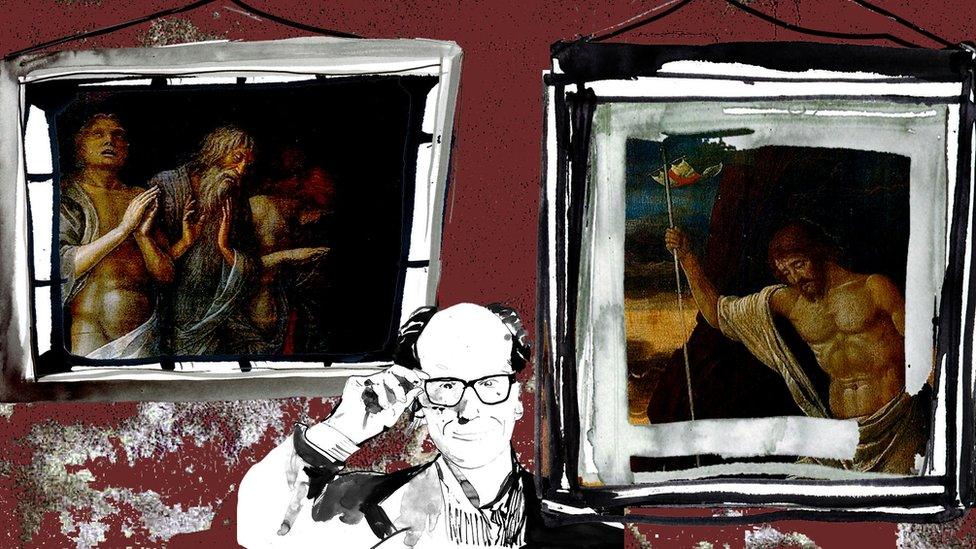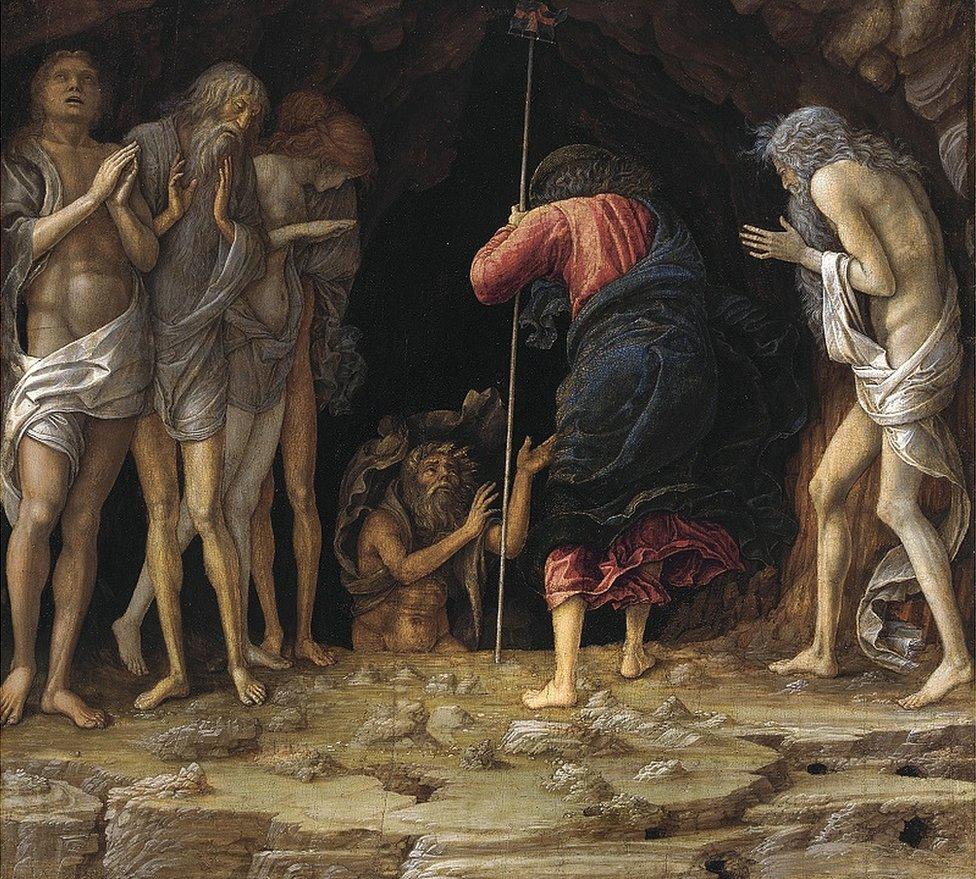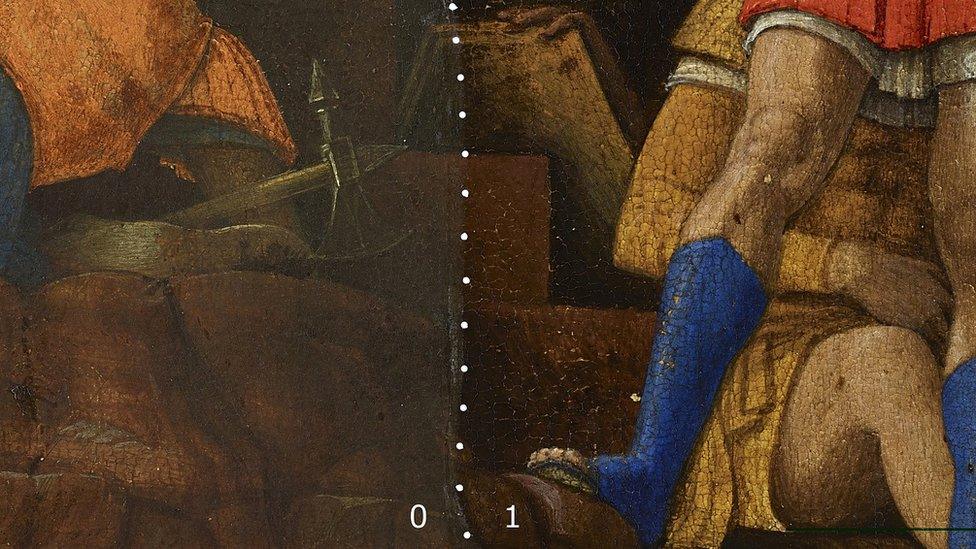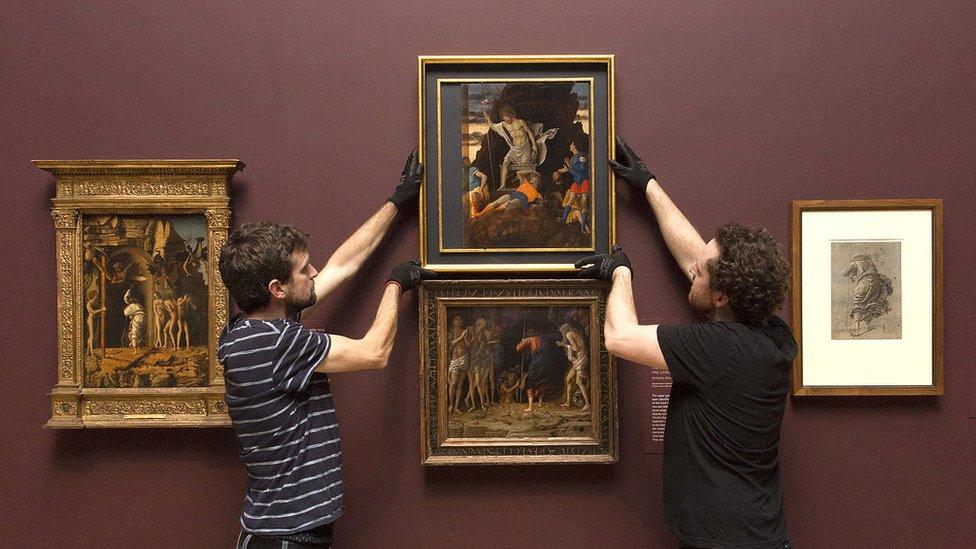Will Gompertz reviews Mantegna's two panels reunited at London's National Gallery ★★★☆☆
- Published

Each year I have to face an awful moment of truth.
It happens on the first morning of every summer holiday when I'm somewhere hot and sunny with friends and family. Drinks are flowing, music is playing.
Everybody is happy. Except for me.
I am as tense as one of Ed Sheeran's guitar strings.
In order to go swimming, which I really want to do, I will have to remove my shirt. In public.
My upper body is never a pretty sight, but at this point in high summer, its shortcomings are comically accentuated by the "T-shirt tan" that reveals light brown extremities incongruously protruding from a pinkish-white torso.
It is a crushing image I am normally able to suppress throughout the winter months, but to my horror it reappeared in an unwanted flashback on Thursday afternoon when I was at the National Gallery in London.
I was visiting the Trafalgar Square institution to see two parts of a panel painting by the great Renaissance master Andrea Mantegna (c 1431-1506), which hadn't been displayed together for maybe 500 years. United, they depict the story of Christ shortly after his crucifixion.
The bottom panel is The Descent of Christ into Limbo (c 1492); the upper piece gives us Part Two, The Resurrection of Christ (c 1492).

The Resurrection of Christ, about 1492, was re-attributed earlier this year to Andrea Mantegna


The Descent of Christ into Limbo was painted by Andrea Mantegna, probably about 1492

There has been much excitement about their reunification, which is great, but in all honesty they make for a very odd couple.
The top panel has been cleaned to within an inch of its life, with the central figure lying beneath Christ's feet grabbing all the attention in his garishly bright orange top and matching knee-length socks.
Meanwhile, the panel below is as sober as a teetotallers' annual convention, with the faded red pigment of Christ's loose-fitting garment the most vivid element of a tonally harmonious painting. It is the stark contrast between the two that conjures up the image of my vacation humiliation.
The fact that the upper painting has been given the full conservation treatment while the picture below has not is nobody's fault - they have different owners. But given the story we are being pitched is the two images were always intended to be seen as one, it seems an odd decision to present them when they are in such dramatically altered states.

The Accademia Carrara in Bergamo says the area on the left shows a part of The Resurrection of Christ, before 19th Century varnish and repaint were removed, and the section on the right is after the restoration
It makes them appear as separate entities by different artists from different times. As, indeed, they may be.
The upper panel has long been thought to be the work of a less accomplished artist than Mantegna.

Andrea Mantegna
Its attribution was seriously questioned in the early 20th Century, since when curators have believed it to be by an apprentice in Mantegna's studio, or possibly by one of the artist's sons, or even a copy made at a later date. That opinion changed earlier this year when Giovanni Valagussa, a curator at Accademia Carrara in Bergamo, which owns The Resurrection of Christ, took the opportunity to spend some time in the store rooms while the gallery was being refurbished.
He happened upon the painting and thought it too good to be by a minor artist.
He then noticed the tip of a cross at the very bottom of the picture, which seemed to be positioned at the entrance to a tunnel or cave. That got Valagussa thinking. Maybe this unloved picture covered in discoloured varnish might be the part of a larger composition.
After a bit of detective work, the curator found the perfect match: Mantegna's uncontested painting, The Descent of Christ into Limbo, which is in private ownership. He immediately spotted the staff in Christ's left hand and saw it was cut off at the top. What if he placed his picture above an image of The Descent, lining up the small Cross at the foot of his image to the pole below?
The result was astonishing.

Accademia Carrara says this HD image of the two panels shows how the arch of the rocks and the Cross at the bottom of The Resurrection of Christ connects with the top of The Descent of Christ into Limbo

Not only was the cross a perfect fit, but once in place, the entire composition connected like a jigsaw to create an overall design that he knew Mantegna had produced many times. Further research revealed that both images were painted using egg tempera on a poplar wood panel with nail holes that lined up, suggesting they were once held together by the same baton.
This led to the conclusion that they would have once formed part of an altar panel in the chapel of the Ducal Palace in Mantua, northern Italy, where Mantegna lived for 50 years, having been hired by the ruling Gonzaga family as their court painter.
He had been born not far away in Padua, into a modest family (his father was an illiterate carpenter), who would never have imagined their young lad would grow up to become a celebrity artist of noble status, living in a splendid house he himself designed.
How the artist managed to climb life's ladder so successfully is evident in the National Gallery exhibition, Mantegna & Bellini, where the two panel paintings were reunited on Thursday.
In the first room of the show, which looks at how the two artists and brothers-in-law riffed off one another, there is a portrait of Saint Mark the Evangelist (c 1448).

Andrea Mantegna showed early talent, painting Saint Mark the Evangelist (c 1448) in his late teens

It is a wonderful picture, painted when Mantegna was just 17 or 18 years old, and already demonstrating an extraordinary talent for naturalism and perspective. OK, the thumb on St Mark's right hand appears to be embedded in his jaw, but other than that it is a notable achievement for one so young.
Mantegna might not be as famous as the big three: Leonardo, Michelangelo and Raphael (the artists, not the Teenage Mutant Ninja Turtles), but when you see this show you wonder why that is the case. When on top form, he was every bit as pioneering and skilful as the three Renaissance greats that came shortly after him.
If you want a masterclass in the art of foreshortening, look no further than this exhibition, where Mantegna shows he can convince in a way the technically gifted Bellini cannot.
All of which makes the introduction of the hyper-cleaned The Resurrection of Christ jar a little. You can see why the curators wanted to show off their discovery, but it feels rushed.

The Resurrection of Christ (above) and The Descent of Christ into Limbo (below) being installed at the National Gallery
Bizarrely, the paintings don't actually look very good together: the frames don't match, the images are too far apart, and the nature of the upper panel's facelift appears crass in comparison to the gracefully aged image below.
It is a three-star exhibit in a five-star show.